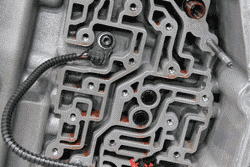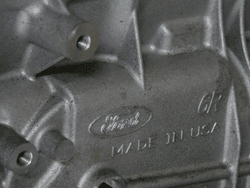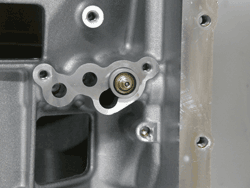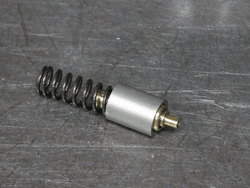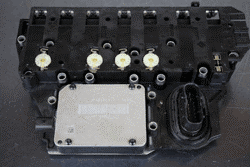The Twists and Turns In Keeping Up With The Changes
From time to time, we hear about how people can be resistant to change and understandably so in many cases. I was very disappointed to hear that GM had to close its Willow Run transmission plant as part of its bankruptcy proceedings. As 2010 came to a close, its 50 plus years of transmission production in that facility also came to a close.
| Meanwhile, other manufacturers increased their production of transmissions. Aisin-Warner became Aisin Seiki early on when they were in a joint venture with Borg Warner. That relationship ended in the late 1980s, and by 2005 it surpassed GM’s Powertrain Division becoming the largest producer of automatic transmissions in the world. Getrag went from being a family firm in the mid-1930s, with motorcycle transmissions and geared components to having a global presence in the market place with their Dual Clutch Transmissions. ZF Friedrichshafen AG, referred to as the ZF Group, has a rich history as well. The company was founded by two men in the early 1900’s with the idea of producing gears for various airships such as the Zeppelin. They now have a very powerful presence in a variety of markets on multiple levels. One of which is automatic transmissions in just about anything that needs a transmission. |
| As these transmission manufacturers grow along with seemingly endless technological advancements, car manufacturers are finding it to be less expensive to buy from these companies rather than producing their own. In some cases, automakers join together in designing transmissions as GM and Ford has done and is doing. They produced their front wheel drive 6-speed transmission together. It must have been a good experience for them, as they are now designing all new 9- and 10-speed transmissions for their 2016 cars, crossovers, SUVs and trucks. |
| In a similar way, when Daimler bought into Chrysler, there emerged transmissions made by Daimler AG that implemented Chrysler’s clutch to clutch technology. We still have to this very day Daimler transmissions in many Dodge, Jeep and Chrysler vehicles. When Ford and Mazda joined together they shared transmissions as well. |
| The result of all of these changes is that we are seeing similar transmissions in a wide variety of different car manufacturers. These progressive changes really dilute what we once called Imports and Domestic vehicles or transmissions. The big three being GM, Ford and Chrysler now seems to be Asian, European and North American. The statements of those who say they only work on domestic vehicles have become questionable. A Dodge vehicle comes in for a repair which is equipped with the New Automatic Gearbox Generation One (NAG1) transmission. This is nothing more then a 722.6 (5G Tronic) transmission used in Mercedes vehicles as far back as 1996. A Mazda vehicle may have any one of Ford’s transmission in it such as the CD4E, 4F27E or the FNR5. Yet a Ford vehicle may have a Mazda transmission in it like the G4A-EL. |
| General Motors for years has been a multinational corporation being involved with a large variety of other automakers and subsidiaries. One would not be quick to think that a SAAB vehicle could have a 6T40 or a 6T70 FWD transmission in it or better yet a 4L60-E. Honda and Acura used GM’s 4L30-E transmission as well as Isuzu and BMW. |
| When automakers decide to buy a transmission from an engineering company, this too places a similar transmission is a wide variety of vehicles. The ZF Group is no slouch in this area. Their transmissions can be found globally in a vast amount of automakers. I think it might be easier to list the ones they have yet to do business with. I thought to list them in alphabetical order and as soon as I wrote down Acura, word has it that the RLX will be getting the ZF9HP48 transmission. So I stopped. |
| The most common ZF transmission in the shops today here in North America is the 5 and 6HP series transmission. The 6HP is predominantly found in Audi, BMW, Jaguar and Land Rover vehicles. You will also find it in Bentley, Hyundai, Maserati, Rolls Royce and even Ford and Mazda. Ford and Mazda refer to this 6HP transmission as their 6R60/6R75/6R80 transmission. |
| Besides having the challenge of knowing what a car or truck uses for a transmission as well as the name it goes by, another dimension that adds to these challenges is when running changes are made to the transmission. The 6HP, for example, has been in existence since 2002. In 2006, some very significant changes took place that greatly affects a technician’s diagnostic approach. The first generation of transmissions is called the ZF6HP19, 26 and 32 while the second generation is called the ZF6HP21, 28 and 34. A newsletter sent out in September called “ZF Generation 1 and 2” covered this change. It covered the significant differences with the solenoids used, their identification, location and operation. Not knowing these differences can be very challenging from a diagnostic standpoint. |
| Ford’s 6R60 underwent internal hard part changes and in 2010 the 6R80 was introduced with an added low one-way clutch for a smoother downshift into first gear. Another interesting aspect that can be observed when an Automaker buys from an engineering company like ZF is that they can implement their own methods of doing things. Case in point, Ford likes using thermal bypass valves in their cooling system. From all the variations of ZF transmissions I have seen here in the U.S., I never have seen one with a thermal bypass valve. |
| This same scenario comes up with GM and Ford working together with their FWD 6 speed transmission. GM calls their smaller version the 6T30/40/45/50 transmission. Ford calls theirs the 6F35. GM did not use a bypass valve inside its transmission (Figure 5), yet Ford did in its (Figures 6 and 7). It is also interesting to compare their own experiences and preferences towards the design and function of a transmission. Ford preferred a Gerotor style pump while GM preferred a crescent style pump.Being inquisitive, I spoke with an engineer about pump differences and why Ford would chose a Gerotor pump and GM a crescent style pump. His answer was that it basically comes down to a combination of what the company has experience with and what they have in regards to proprietary intellectual property. |
| More teeth was always better in the past as it gave a higher pump frequency and better flow performance at low speed which favored crescent pumps. With having improvements over valve body leakages, manufacturers are getting away with smaller pumps at idle, hence vane pumps are coming back as are Gerotors. These days Gerotor pumps have come a long way and are becoming the pump of choice of many manufacturers, especially where the pump is electrically driven or are offset (i.e. chain drive) away from the Torque Converter. Gerotors can package nicely in a small diameter space, as can vane pumps. |
| Gerotor pumps are much less expensive and easier to make as they do not have to control the critical machining necessary as with a crescent pump. GM has had a long history using crescent style pumps so it is interesting to see how they chose to go the more expensive route with their 6T40 series transmissions. |
| This transmission is yet another example of staying up on changes as GM made very significant ones with their 6T40 and 6T70 series transmissions. As with ZF, Generation 1 and Generation 2 are terms used to designate these very significant changes. One such change is, Generation 1 6T40 series transmissions used pressure switches in the TEHCM assembly while Generation 2 does not. This all relates to the method used in clutch adaptation which means noteworthy changes also took place with programming. And this is just one of the many changes that took place. Ford chose not to put the TCM in their version of this transmission and so they never had these pressure switches from the get go. |
| This article only scratched the surface of all the variations, differences, changes and similarities that occur in the transmission industry. Getting into the transmission used between Mitsubishi, Hyundai and Kia vehicles along with the changes and variations that go with it is quite formidable.
Or mentioning the Japanese Automatic Transmission Company (Jatco); a subsidiary of Nissan which Mazda was once a part of but now Mitsubishi is. They make a CVT transmission which is being used in Dodge, Jeep, Nissan and Mitsubishi vehicles. Honda, who for the most part manufacturers their own transmissions, is in a league of their own. The variations of transmissions they produce seem never ending. You would think the cost involved in development and tooling would be a deterrent yet it is not. Toyota uses transmissions from Aisin, its subsidiary producing quite an array of transmissions along with changes as well. The twists and turns in keeping up with all the changes in the transmission industry are no doubt challenging. It is a maze and can be very difficult to keep up with it all. ATSG work’s very hard at trying to get this information out to the aftermarket along with problems and fixes. It is challenging work as most manufacturers withhold this type of information. When it comes to identifying the type of transmission being used in a car or truck, one source that has been very helpful is the original guide to Automatic Transmissions by vehicle by Transtec. The names given to these transmissions are yet another dimension adding to the calamity in keeping up with the changes. We have techs calling in on our ATSG technical helpline saying, I’m not sure of the name of the transmission I am working on but I need your help. It sounds odd but I totally understand the dilemma. Just flip through this guide and you can see how helpful it will be. Looking forward, the task of keeping up with all these changes will still have its twists and turns. Subaru will continue with Jatco design CVT’s as their only type of transmission. Word has it that Honda will be doing the same with their own design. Dodge seems to be leaning towards using the Getrag Dual Clutch Transmissions. ZF8 and 9 speeds have already taken a nice size bite in the auto industry with 10 speeds from GM and Ford on their way. With the way automakers and engineering companies’ design and change automatic transmissions so frequently, keeping up with the changes seems more like keeping up with the Joneses. If you found this article to be helpful, let us know below. If you need technical help from one of our tech experts, give us a call at 1-800-245-7722 and we will be more than happy to assist in getting that job done and the customer out the door! |


